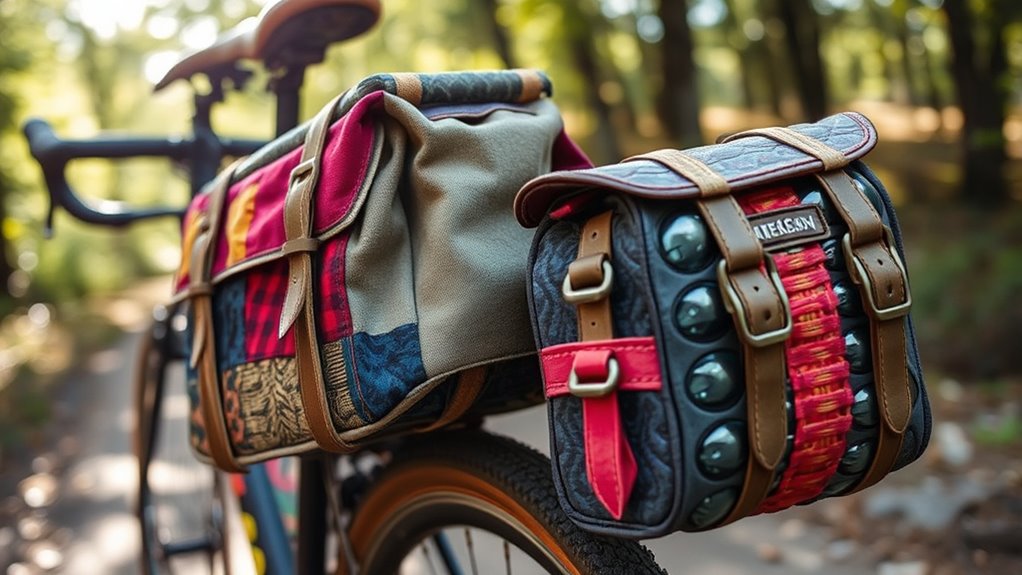To create upcycled DIY bikepacking gear, gather recycled materials like old backpacks, fabric scraps, or plastic containers. Reinforce and waterproof them for durability and weather resistance. Sew or attach these materials into custom storage solutions such as handlebar bags, frame packs, or small jars for essentials. Focus on eco-friendly, budget-friendly designs that reflect your style and needs. Keep exploring different ideas to build sustainable, personalized gear that enhances your rides and your impact on the environment.
Key Takeaways
- Repurpose durable materials like old backpacks, tarps, or fabric scraps to create custom, eco-friendly bikepacking gear.
- Use recycled containers such as jars or plastic crates for organized storage of small and large items.
- Sew waterproof pouches and bags from upcycled fabric to protect electronics and valuables during rides.
- Build lightweight frame packs and handlebar bags using recycled nylon or canvas for cost-effective customization.
- Emphasize sustainability by selecting biodegradable materials and reinforcing old gear with waterproofing for long-lasting use.

Bikepacking is all about adventure, but you don’t need to spend a fortune on gear. Instead, you can craft your own upcycled gear using sustainable materials and clever storage solutions. This approach not only saves money but also reduces waste and gives your bikepacking setup a unique, eco-friendly edge. By repurposing items you already have or sourcing discarded materials, you create gear that’s both functional and environmentally responsible.
Start by looking around your home and local thrift stores for durable materials like old backpacks, fabric scraps, or sturdy plastic containers. These can be transformed into panniers, handlebar bags, or frame packs. For instance, an old canvas bag can be reinforced with some waterproofing spray and used as a saddlebag or a front rack pouch. Using sustainable materials means choosing items that are long-lasting and ideally biodegradable, so your gear won’t just serve you well on your trip but also leave a smaller environmental footprint.
When it comes to storage solutions, think outside the box. Creative storage doesn’t mean complex or expensive; it’s about making the most of what you have. For example, repurposed jars or bottles can hold small essentials like snacks, tools, or first aid supplies. An unused plastic crate can be attached to your bike frame for larger gear, or you can sew waterproof pouches from recycled fabric to keep your electronics and valuables safe from rain. The key is to make certain your storage solutions are secure, weatherproof, and accessible while you’re riding. Using adjustable straps, bungee cords, or even repurposed velcro strips can help you attach and organize your gear efficiently.
DIY projects like sewing your own handlebar bag from old tarps or creating lightweight frame packs from recycled nylon are both budget-friendly and eco-conscious. These solutions allow you to customize your setup based on your specific needs, whether it’s extra room for clothing or compartments for electronics. Plus, building your own gear from upcycled materials gives you a sense of pride and connection to your gear, making each adventure even more meaningful.
In the end, upcycled DIY bikepacking gear isn’t just about saving money; it’s about embracing sustainability and creativity. Incorporating special event planning principles can help you organize and execute your bikepacking projects more effectively, ensuring a successful and enjoyable experience. By choosing eco-friendly materials and clever storage options, you build a gear setup that’s uniquely yours, lightweight, and kind to the planet. With a little effort and imagination, you can prepare for your next ride without breaking the bank or harming the environment.
Frequently Asked Questions
What Safety Tips Should I Follow When Creating DIY Bikepacking Gear?
When creating DIY bikepacking gear, you should prioritize safety by adding reflective features for visibility and ensuring proper weight distribution to maintain balance. Use durable materials and double-check all fastenings before your ride. Avoid overloaded gear that could affect handling, and keep emergency supplies accessible. Regularly inspect your gear for wear and tear. These steps help keep you safe, visible, and comfortable on your adventures.
Which Materials Are Safest for Upcycled Bikepacking Projects?
You should prioritize safe, durable materials like recycled nylon, aluminum, and sturdy plastics for your upcycled bikepacking projects. Avoid recycling myths that suggest all recycled materials are unreliable; instead, focus on properly processed, recycled metals and fabrics known for their strength. Remember, material recycling promotes sustainability while ensuring your gear remains safe and reliable. Always verify the source and integrity of recycled materials before incorporating them into your DIY gear.
How Do I Ensure Durability of Upcycled Gear During Long Trips?
To make certain your upcycled gear lasts during long trips, focus on proper gear maintenance and addressing recycling challenges. Regularly inspect and reinforce seams, zippers, and straps. Use durable, weather-resistant coatings on vulnerable areas. Clean and dry your gear after each ride to prevent deterioration. Choosing sturdy, repurposed materials and addressing recycling challenges early on helps maintain durability, ensuring your gear withstands the demands of extended adventures.
Can Upcycled Gear Withstand Extreme Weather Conditions?
Ever wonder if upcycled gear can handle extreme weather? The answer is yes, if you choose the right materials and add weather-resistant coatings. Upcycled gear built with durable fabrics like waterproofed repurposed nylon or treated canvas can withstand rain, wind, and snow. While it may not match industrial-grade equipment, proper material selection and reinforcement considerably improve weather resistance, making your gear more reliable during tough conditions.
Are There Eco-Friendly Alternatives to Common Bikepacking Materials?
Yes, eco-friendly alternatives to common bikepacking materials exist. You can choose fabrics made from recycled plastics or organic fibers, which help address recycling challenges and reduce environmental impact. When sourcing materials, look for sustainable options that are durable and lightweight. By opting for recycled or natural materials, you support eco-conscious choices and minimize your carbon footprint, all while creating functional gear tailored to your bikepacking adventures.
Conclusion
Just like a skilled gardener tends to their plants, your creativity can turn discarded items into sturdy bikepacking gear. Each upcycled piece is a seed planted in the soil of sustainability, growing into a resilient companion on your adventures. With a little effort and imagination, you’re not just riding a bike—you’re nurturing a movement that values resourcefulness. Keep crafting, keep exploring—your journey is the garden, and every DIY creation is a blooming demonstration of your ingenuity.
















